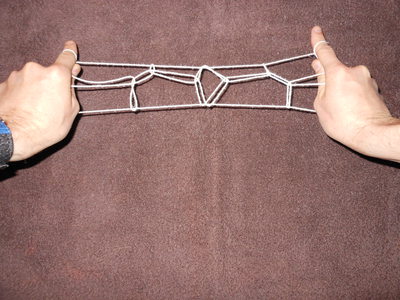

LLX > Neil Parker > String Figures > Odds & Ends


In [Jayne 1906], the figure "Carrying Money" from Yap is completed by removing the figure from the hands and forming additional loops artificially. Jayne writes,
As this particular figure was shown to Dr. Furness by a young boy, one might reasonably suspect that there is another way of doing it which he did not know; but I have seen an Eskimo make a figure in a similar manner and it is possible that the finished figures (which I give farther on) from the Nauru, or Pleasant, Island of the Marshall Islands, were, to some extent, made artificially. Obviously, figures formed in this way are less interesting than those developed entirely on the hands.
It's not hard to agree that such "artifical" methods make a figure less elegant, but fortunately, there is a way to make Carrying Money entirely on the fingers, and the key is a move common in figures from Nauru - indeed, [Maude 2001] gives two figures (figures 55, Amen Ranga Ekwan, keepers of the sun, and 56, Imwingen-kuri, wooden cross-pieces for strengthening houses) that come out almost (but not quite) the same as Carrying Money, made entirely without setting the figure down.
The method below is based on the Nauruan figures. Of course I have no idea whether anything like this method was ever used on Yap to make Carrying Money.
1. Make Ten Men (for instructions, see the Australian figure Turtle: The Scutum).
2. Release thumb loops, and let the strings hang loosely. With thumbs, pick up near index strings (the ones that formerly went to the thumbs), close to indexes, from below. Let this string slip entirely off indexes, and release middle finger loops. Extend loosely.
3. Insert little fingers into index loops from above, and return with near index strings. Release index loops.
4. With right thumb and index, grab left near little finger string a short distance from the finger. Make a small loop on it by giving it a half-twist clockwise, and then another half-twist clockwise. Place the small loop over left thumb.
5. With right thumb and index, reach down through small upper left thumb loop, and grab lower left thumb loop. Pull lower loop up through upper loop, and release both loops from left thumb. Replace loop held by right thumb and index on left thumb.
6. Repeat steps 4 and 5 on other hand (making the twist in the opposite direction). Push small loops encircling thumb loops toward center of figure.
7. With right thumb and index, grab left far thumb string a short distance from thumb, and make a small loop in it by giving it a single half-twist clockwise. Place small loop over left little finger.
8. Repeat step 5 on left little finger.
9. Repeat steps 7 and 8 on other hand (making the twist in the opposite direction). Push small loops encircling little finger loops toward center of figure.
10. Insert indexes into thumb loops from above, and return with near thumb strings. Release thumb loops.
11. Pass thumbs under index loops, and insert into little finger loops from below. Return with near little finger strings.
12. Insert thumbs into index loops from below, and return with near index strings.
13. Caroline extension.